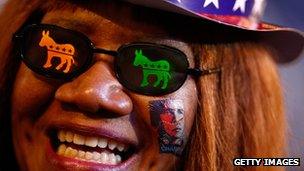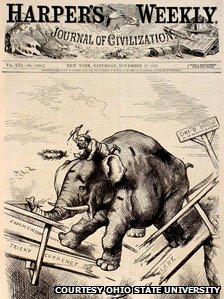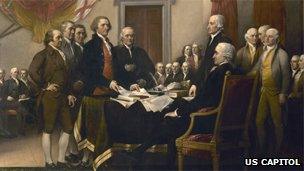Glossary: US elections
- Published
What is the difference between Medicare and Medicaid? What are blue dogs and red states? These are just a few of the many well-used but often misunderstood terms in US politics.
D-G
D
Delegates The party members whose votes at the national convention officially determine the two parties' presidential candidates.
Most of the delegates at the convention are obligated to vote for the candidate chosen in primary elections or caucuses in their home state. They are referred to as pledged or elected delegates. Some delegates, however, are unpledged and are able to vote for any candidate at the convention.
In the Democratic Party, these unpledged delegates are called super-delegates. They include senior members of the party hierarchy and rank-and-file members elected to the Democratic National Committee, the party's governing body.

Democratic voters have embraced the donkey as the party's unofficial symbol
Donkey, Democratic The donkey has become the established - although unofficial - political symbol for the Democratic Party. Democratic Party historians say the symbol was first used during Andrew Jackson's presidential campaign in 1828.
Labelled a jackass by his opponents, he adopted the donkey for his campaign posters and it stuck with him.
New York cartoonist Thomas Nast, a radical Republican, later also used the donkey to represent a group of northern anti-civil war Democrats, and more generally as a symbol for pro-Democrat editors and newspapers.
By the end of the 19th Century, the symbol was firmly established.
E
Electoral College The collective term for the 538 electors who officially elect the president and vice-president of the United States.

The symbol was born amid largely forgotten 19th Century political battles
Presidential candidates require a majority of 270 college votes to win the presidency. The number of electors for each state is equal to the combined total of its senators and representatives in Congress.
The college system was conceived before the existence of political parties and was designed to allow the electors to act as independent voters. Electors are now expected to follow the wishes of the majority of voters in each state.
However, there have been a number of cases in recent elections where at least one elector has voted for a candidate other than the one they were pledged to. Two states, Nebraska and Maine, now divide their electors in proportion to the popular vote given to each candidate.
Elephant, Republican The traditional symbol for the Republican Party, believed first to have been used in that context by an Illinois newspaper during Abraham Lincoln's 1860 election.
Thomas Nast popularised the image in a cartoon in a 1874 edition of Harper's Weekly, as pro-Democrat newspapers were accusing the Republican president of Caesarism for allegedly seeking a third term in office.
F
Federal Election Commission (FEC) In 1975, Congress created the Federal Election Commission as an independent regulatory agency to administer and enforce federal election law.
The FEC, external discloses campaign finance information, enforces the law and oversees the public funding of presidential elections. By law, no more than three of the six members of the commission can be members of the same political party.
During an election period, the commission collects and publishes lists of contributions to all the official candidates, as well as their campaign spending.
Federal Election Campaign Act (FECA) First implemented in 1971, the Federal Election Campaign Act is a US federal law that provides for the disclosure of financial contributions to federal campaigns and regulates contributions.
In 1974, the law was toughened and new amendments established strict disclosure requirements for campaign donations, set specific limits for those donations, instituted public financing of presidential elections, and established the Federal Election Commission (FEC) to govern the whole process.
Subsequently, many of the restrictions on campaign spending and contributions have been pared back in a series of Supreme Court decisions.
Filibuster A parliamentary technique of delaying a vote to pass legislation by giving a long speech.
In the Senate, it takes 60 votes to defeat a filibuster by ending debate on a bill.
In current practice, the minority party needs only to threaten a filibuster to block legislation, because the majority party typically holds less than 60 votes needed to end debate on a bill and move to a final vote.
One of the most infamous uses of the filibuster came in 1957, when South Carolina Democrat Strom Thurmond gave a 24-hour tirade against a piece of civil rights legislation, in an ultimately unsuccessful effort to block it.
Founding fathers An imprecise term used most often to describe those involved in drafting the Declaration of Independence from Britain in 1776 and the framing and adoption of the constitution at the Philadelphia Convention of 1787.

A painting by John Trumbull depicts the Founding Fathers drafting the Declaration of Independence
The term is sometimes also used to include influential figures in the struggle for independence and those who fought the Revolutionary War.
Front-loading The tendency, which has become more marked in recent years, for states to move their primaries and caucuses forward, in an attempt to be among the first states holding a nominating contest.
State authorities believe that coming at the front of the queue increases their influence on the nomination process. However, if too many states hold their contests in a short space of time, critics argue, candidates are unable to connect with voters in each individual state.
A side-effect is that the process starts earlier in the year and is drawn out over a longer period.
G
Gaffe A verbal error or slip-up made by a politician or other political figure. Or in a famous formulation by American journalist Michael Kinsley, a gaffe is when a politician accidentally says something he or she really means but that was better left unsaid.
Gerrymandering The practice of drawing political constituency maps to increase a particular candidate's or party's advantage in a subsequent election.

Sophisticated gerrymandering produces House districts in unusual shapes, like California's 38th
In its rawest form, gerrymandering is when politicians choose their voters, rather than voters choosing their politicians.
In the US, political district maps are typically redrawn once a decade following the completion of the census.
The party in power in a state government uses sophisticated mapping and statistical data to redraw the map to ensure its candidates have the best chance of success, usually by diluting the electoral strength of the opposition party's supporters.
One mechanism might involve splitting a city into two or more House districts, each of which is then dominated by suburban voters.
Governor The elected official of a state who is responsible for the effective and efficient workings of its government.
A governor's term of office lasts for four years. The number of times a governor can be re-elected varies from state to state.
Grand Old Party (GOP) The traditional nickname for the Republican Party widely used in American political reporting.
The party's official history traces the term back to the late 19th Century citing an article in the Boston Post headlined: The GOP Doomed.
The party website suggests the term may have evolved from the term used to refer to British Prime Minister William Gladstone - the Grand Old Man.
In Richard Nixon's 1964 presidential campaign, the GOP was used briefly as the basis for the slogan the "Go-Party", but by the late 1970s it had become firmly associated with the term Grand Old Party.